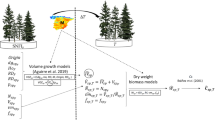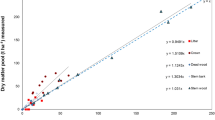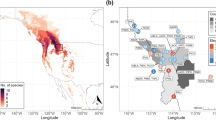Abstract
Context
The fuel complex variables canopy bulk density and canopy base height are often used to determine crown fire initiation and spread. Direct measurement of these variables is impractical, and they must be estimated indirectly.
Aims
The objectives of the present study were to model the vertical profile of available crown fuel in maritime and radiata pine stands in NW Spain, using data from destructively sampled trees; to compare the values of the canopy fuel variables estimated by two different methods and to estimate these variables from common stand descriptors.
Methods
Systems of equations were fitted simultaneously to address the inherent correlations between available crown fuel components and between the canopy fuel variables. Heteroscedasticity and autocorrelation were also taken into account in the fitting process, where necessary.
Results
The values of the canopy fuel variables varied greatly depending on the estimation method used. Models for predicting the variables at stand level explained a high percentage of the observed variability. Crowning is more likely in maritime pine than in radiata pine stands.
Conclusions
Although the approach used in this study provides a realistic depiction of the vertical distribution of crown fuel, it departs from the requirements of Van Wagner’s model. The method used to estimate canopy fuel variables affects fire modelling results and thus the design of fuel treatment projects.




Similar content being viewed by others
References
Agca M, Popescu SC, Harper CW (2011) Deriving forest canopy fuel parameters for loblolly pine forests in eastern Texas. Can J For Res 41:1618–1625
Agee JK (1996) The influence of forest structure on fire behaviour. In: Cooper SL (ed) Proceedings of the 17th annual forest vegetation management conference, Shasta County Cooperative Extension, University of California, pp 52–68, Redding (California)
Alexander ME (2006) Models for predicting crown fire behavior—a review. In: V Short course on fire behaviour, Association for the Development of Industrial Aerodynamics, Forest Fire Research Centre, Coimbra (Portugal)
Alexander ME, Cruz MG (2011) Crown fire dynamics in conifer forests. In: Synthesis of knowledge of extreme fire behavior: volume I for fire managers. USDA Forest Service Gen. Tech. Rep. PNW-GTR-854, pp 107–142, Portland (Oregon)
Alexander ME, Stefner CN, Mason JA, Stocks BJ, Hartley GR, Maffey ME, Wotton BM, Taylor SW, Lavoie N, Dalrymple GN (2004) Characterizing the jack pine-black spruce fuel complex of the International Crown Fire Modelling Experiment (ICFME). Canadian Forest Service Information Report NOR-X-393. Northern Forestry Centre, Edmonton
Balboa-Murias MA, Rodríguez-Soalleiro R, Merino A, Álvarez-González JG (2006) Temporal variations and distribution of carbon stocks in aboveground biomass of radiata pine and maritime pine pure stands under different silvicultural alternatives. For Ecol Manage 237:29–38
Belsley DA (1991) Conditioning diagnostics: collinearity and weak data in regression. Wiley, New York
Call PT, Albini FA (1997) Aerial and surface fuel consumption in crown fires. Int J Wildland Fire 7:259–264
Castedo-Dorado F, Diéguez-Aranda U, Barrio-Anta M, Sánchez-Rodríguez M, von Gadow K (2006) A generalized height-diameter model including random components for radiata pine plantations in northwestern Spain. For Ecol Manage 229:202–213
Castedo-Dorado F, Gómez-García E, Diéguez-Aranda U, Barrio-Anta M, Crecente-Campo F (2012) Aboveground stand-level biomass estimation: a comparison of two methods for major forest species in northwest Spain. Ann For Sci 69:735–746
Crecente-Campo F (2008) Modelo de crecimiento de árbol individual para Pinus radiata D. Don. en Galicia. Ph D thesis, University of Santiago de Compostela
Cruz MG (2011) Fuels and fire behaviour potential associated with FMZ. CSIRO Ecosystem Sciences. Report prepared for ForestrySA, Canberra
Cruz MG, Alexander ME (2010) Assessing crown fire potential in coniferous forest of western North America: a critique of current approaches and recent simulation studies. Int J Wildland Fire 19:377–398
Cruz MG, Alexander ME (2012) Evaluating regression model estimates of canopy fuel stratum characteristics in four crown fire-prone fuel types in western North America. Int J Wildland Fire 21:168–179
Cruz MG, Alexander ME, Wakimoto RH (2003) Assessing canopy fuel stratum characteristics in crown fire prone fuel types of western North America. Int J Wildland Fire 12:39–50
Cruz MG, Alexander ME, Wakimoto RH (2004) Modeling the likelihood of crown fire occurrence in conifer forest stands. For Sci 50:640–658
Cruz MG, Alexander ME, Wakimoto RH (2005) Development and testing of models for predicting crown fire rate of spread in conifer forest stands. Can J For Res 35:1626–1639
Cruz MG, Alexander ME, Wakimoto RH (2010) Comment on “Estimating canopy fuel characteristics in five conifer stands in the western United States using tree and stand measurements”. Can J For Res 40:2262–2263
Diéguez-Aranda U, Rojo A, Castedo-Dorado F, Álvarez JG, Barrio-Anta M, Crecente-Campo F, González JM, Pérez-Cruzado C, Rodríguez R, López-Sánchez CA, Balboa-Murias MA, Gorgoso JJ, Sánchez F (2009) Herramientas selvícolas para la gestión forestal sostenible en Galicia. Consellería do Medio Rural, Xunta de Galicia, Santiago de Compostela
Fernandes PM, Rigolot E (2007) The fire ecology and management of maritime pine (Pinus pinaster Ait.). For Ecol Manage 241:1–13
Fernandes PM, Loureiro CA, Botelho HS, Ferreira A, Fernandes M (2002) Avaliaçao indirecta da carga de combustível em pinhal bravo. Silva Lusit 10:73–90
Hall SA, Burke IC (2006) Considerations for characterizing fuels as inputs for fire behaviour models. For Ecol Manage 227:102–114
Hevia A, Crabiffosse A, Majada J, Álvarez-González JG, Ruiz-González AD (2011) Modelo de distribución de la carga de combustibles finos en el dosel de copas de rodales regulares de Pinus pinaster: efecto de claras combinadas con podas. In: III Reunión del grupo de trabajo de modelización forestal de la SECF, Lugo (Spain)
Keane RE, Reinhardt ED, Scott J, Gray K, Reardon J (2005) Estimating forest canopy bulk density using six indirect methods. Can J For Res 35:724–739
Keeley JE, Zedler PH (1998) Evolution of life histories in Pinus. In: Richardson DM (ed) Ecology and biogeography of Pinus. Cambridge University Press, Cambridge, pp 219–250
Keyes CR, O’Hara KL (2002) Quantifying stand targets for silvicultural prevention of crown fires. West J Appl For 17:101–109
Keyser T, Smith FW (2010) Influence of crown biomass estimators and distribution on canopy fuel characteristics in ponderosa pine stands of the Black Hills. For Sci 56:156–165
Mitsopoulos ID, Dimitrakopoulos AD (2007) Canopy fuel characteristics and potential crown fire behaviour in Aleppo pine (Pinus halepensis Mill.) forests. Ann For Sci 64:287–299
MMA (2006) Los incendios forestales en España. Decenio 1996–2005. Ministerio de Medio Ambiente, Madrid
Parresol BR (1999) Assessing tree and stand biomass: a review with examples and critical comparisons. For Sci 45:573–593
Reeves MC, Ryan KC, Rollins MG, Thompson TG (2009) Spatial fuel data products of the LANDFIRE Project. Int J Wildland Fire 18:250–267
Reinhardt E, Scott J, Gray K, Keane R (2006) Estimating canopy fuel characteristics in five conifer stands in the western United States using tree and stand measurements. Can J For Res 36:2803–2814
Ruiz-González AD, Álvarez-González JG (2011) Canopy bulk density and canopy base height equations for assessing crown fire hazard in Pinus radiata plantations. Can J For Res 41:839–850
Sando RW, Wick CH (1972) A method of evaluating crown fuels in forest stands. USDA Forest Service Res Pap NC-84
SAS Institute Inc (2008) SAS/ETS® 9.2 user’s guide. SAS Institute Inc, Cary
Scott JH, Reinhardt ED (2001) Assessing crown fire potential by linking models of surface and crown fire behaviour. USDA Forest Service Res Pap RMRS-RP-29
Stocks BJ, Alexander ME, Wotton BM, Stefner CN, Flannigan MD, Taylor SW, Lavoie N, Mason JA, Hartley GR, Maffey ME, Dalrymple GN, Blake TW, Cruz MG, Lanoville RA (2004) Crown fire behaviour in a northern jack pine-black spruce forest. Can J For Res 34:1548–1560
Van Wagner CE (1977) Conditions for the start and spread of a crown fire. Can J For Res 7:23–34
Vega JA, Rey E, Ruiz Pérez I, Jiménez E, Pérez Suárez JR (2009) Estudio de tratamientos preventivos de incendios sobre la estructura del complejo integral de combustible forestal en masas de Pinus pinaster Ait. de Castilla y León. In: V Congreso Forestal Español, Ávila (Spain)
Williams DF (1978) Fuel properties before and after thinning in young radiata pine plantations. Fire Management Branch, Department of Conservation and Environment, Research Report NO. 3, Victoria
Xunta de Galicia (2001) O monte galego en cifras. Consellería de Medio Ambiente, Xunta de Galicia, Santiago de Compostela
Acknowledgments
The authors are grateful to two anonymous reviewers whose comments substantially improved an earlier version of this manuscript.
Funding
Funding for this research was provided by the Spanish Ministry of Science and Innovation, project No. AGL2008-02259/FOR.
Author information
Authors and Affiliations
Corresponding author
Additional information
Handling Editor: Eric Rigolot
Contribution of the co-authors
Iban Gómez-Vázquez analysed the data and wrote the manuscript. Felipe Crecente-Campo collected the data, provided technical assistance in model fitting and supervised the writing of the manuscript. Ulises Diéguez-Aranda provided part of the experimental data and revised the text. Fernando Castedo-Dorado developed the experimental design, coordinated the research project and supervised the work.
Rights and permissions
About this article
Cite this article
Gómez-Vázquez, I., Crecente-Campo, F., Diéguez-Aranda, U. et al. Modelling canopy fuel variables in Pinus pinaster Ait. and Pinus radiata D. Don stands in northwestern Spain. Annals of Forest Science 70, 161–172 (2013). https://doi.org/10.1007/s13595-012-0245-9
Received:
Accepted:
Published:
Issue Date:
DOI: https://doi.org/10.1007/s13595-012-0245-9




